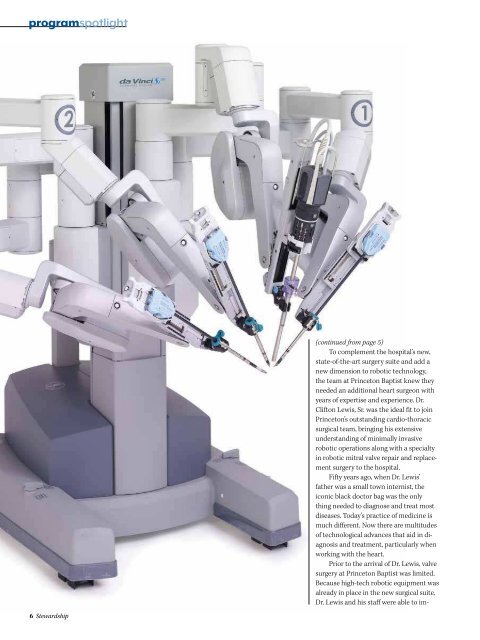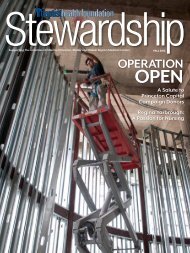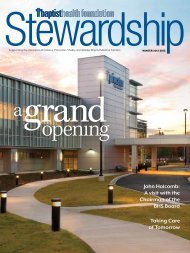Spring/Summer 2013 - Baptist Health Foundation
Spring/Summer 2013 - Baptist Health Foundation
Spring/Summer 2013 - Baptist Health Foundation
Create successful ePaper yourself
Turn your PDF publications into a flip-book with our unique Google optimized e-Paper software.
programspotlightAlong with the latest technology, Dr. Lewis knows that it’sthe people who are the pulse of any hospital.mediately fill a range of surgical needs forPrinceton patients.“We brought a whole team to supportthis effort, and we were up and runningwith no learning curve,” says Dr. Lewis.“The environment provides us everythingwe need to perform these highly specializedsurgeries; it’s a turnkey operation,and we are proud to offer the most experiencein the state of Alabama and Southeasthere at Princeton.”Integrating cutting-edge technologywith the most knowledgeable and skilledstaff is what propelled Princeton PresidentBetsy Postlethwait to recruit Dr. Lewis andhis team. “A commitment to our patientsis what drives us at Princeton <strong>Baptist</strong>,”says Postlethwait. “As we added the latestand greatest technology during our expansionproject, we knew we also neededthe best in the practice of robotic surgeryto use these tools to their fullest potential.What intrigued me about Dr. Clifton Lewiswas not only his extensive expertise butthe passion he brings to his profession.”With approximately 700 robotic heartoperations and more than 1,500 minimallyinvasive cardiac operations performedover the last nine years, Dr. Lewis’ experienceand reputation makes him a leaderin the field of robotic heart surgery.”Dr. Lewis conducts the most intricateoperations using one of the hospital’s daVinci robots. Located within the hospital’snewly constructed, state-of-the-art surgerycenter, this equipment is the latestin robotic technology. Dr. Lewis says thiswas a motivating factor for relocating hispractice, “Princeton has the most modern,most technologically-advanced operatingsuites in the state. The environment providesus everything we need to performthese highly specialized operations.”Patients are intrigued by the robotand want to know about the relationshipbetween the surgeon and robotic technology.“One of the most common questionsI hear is ‘does the robot do the surgery?’”remarks Dr. Lewis. ”Nothing could befurther from the truth. Really, the robotis just a fancy, complex, very advancedinstrument that is under the completecontrol of the surgeon and his assistant at(continued from page 5)To complement the hospital’s new,state-of-the-art surgery suite and add anew dimension to robotic technology,the team at Princeton <strong>Baptist</strong> knew theyneeded an additional heart surgeon withyears of expertise and experience. Dr.Clifton Lewis, Sr. was the ideal fit to joinPrinceton’s outstanding cardio-thoracicsurgical team, bringing his extensiveunderstanding of minimally invasiverobotic operations along with a specialtyin robotic mitral valve repair and replacementsurgery to the hospital.Fifty years ago, when Dr. Lewis’father was a small town internist, theiconic black doctor bag was the onlything needed to diagnose and treat mostdiseases. Today’s practice of medicine ismuch different. Now there are multitudesof technological advances that aid in diagnosisand treatment, particularly whenworking with the heart.Prior to the arrival of Dr. Lewis, valvesurgery at Princeton <strong>Baptist</strong> was limited.Because high-tech robotic equipment wasalready in place in the new surgical suite,Dr. Lewis and his staff were able to imthepatient-side cart.” The advantages ofthe minimally invasive robotic approachinclude quicker recovery, reduced bleeding,infection risk nearly eliminated andsuperior aesthetics related to incisionsand scarring. [see sidebar: How it Works]Along with the latest technology, DrLewis knows that it’s the people who arethe pulse of any hospital. He credits thenursing leadership of Regina Yarborough(Princeton’s chief nursing officer) and herexceptional staff as an important factorin his decision to move his practice toPrinceton. “The nursing leadership hereis head and shoulders above anyone inthe city,” says Dr. Lewis. “They organizethis talented and dedicated nursing staffbetter than any I’ve seen and, in turn, thatallows nurses to flourish.”“Improving through innovation isa driving force at Princeton <strong>Baptist</strong> andthroughout <strong>Baptist</strong> <strong>Health</strong> System,” saysPostlethwait. “As we grow and adapt tochanging times, we continue to seek newways to better serve our patients.” AndDr. Clifton Lewis agrees. It is his commitmentto his patients that keeps himpassionate about his work. “If you knowyou can offer the most advanced, leastinvasive, most modern surgery available,and provide excellent outcomes—thatfeels good. Especially when we’re able toextend our reach to patients who may nothave been able to otherwise be served.”Our hospitals’ ability to provide theinnovation capital necessary to offer newtechnology and services to patients will beseverely impacted by health care reform legislation.Now, more than ever, the support ofour donors is needed. To learn how you canhelp support innovation at BHS hospitals,call 1-877-474-4243 or visit our web site:www.baptisthealthfoundation.com.robotic surgery – how it worksThe da Vinci SurgicalSystem enables surgeonsto perform delicate andcomplex operations througha few tiny incisions withincreased vision, precision,dexterity and control. Thesystem consists of several keycomponents, including:n an ergonomically designedconsole where the surgeonsits while operating,n a patient-side cart wherethe patient lays duringsurgery,n four interactiverobotic arms,n a high-definition 3Dvision system,n and proprietary EndoWrist®instruments.Da Vinci is powered bystate-of-the-art robotictechnology that allows thesurgeon’s hand movementsto be scaled, filtered andtranslated into precisemovements of the EndoWristinstruments working insidethe patient’s body.Along with the benefitsto patients, surgeons areimpressed with the da Vinci’simproved dexterity andrange of motion, superioroptics and superior threedimensionalviewing to helpseparate tissue very gently.Improving through innovation isa driving force at Princeton <strong>Baptist</strong> andthroughout <strong>Baptist</strong> <strong>Health</strong> System.—Betsy Postlethwait6 Stewardship<strong>Spring</strong>/<strong>Summer</strong> <strong>2013</strong> 7








